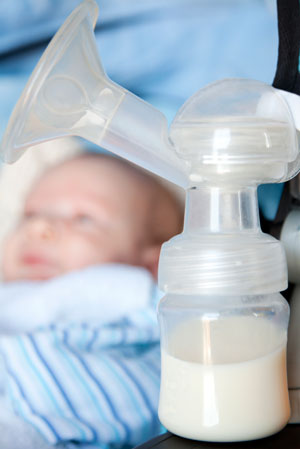
All you need to know about this lifesaving gadget that makes breastfeeding manageable for working moms.
By now, most people know that breastfeeding has been associated with a wide number of benefits to both baby and mom. Who hasn’t heard the phrase “breast is best”? Benefits for baby include protection against many different illnesses and diseases. Long-term benefits include reduced risk for childhood and adult obesity, diabetes, and even childhood leukemia and lymphoma. Benefits to mom include faster healing after delivery, lower risk for postpartum depression, as well as decreased lifetime risks for diabetes, cardiovascular disease, rheumatoid arthritis, hypertension, and breast and ovarian cancer.
To provide the most benefits to baby and mom, the American Academy of Pediatrics recommends babies be exclusively breastfeed until 6 months, with continued breastfeeding until at least 1+ years as other foods are introduced. However, according to the U.S. Department of Health and Human Services, up to 1/3 of working women do not take any maternity leave. Of those who do, the average maternity leave lasts a mere 10.3 weeks. Assuming most working moms don’t have the luxury of bringing baby to work to feed on demand, that’s far short of the recommended 6 months.
Enter the breast pumps. They not only collect milk without baby, but they can help stimulate and keep milk production up. There are many different types of pumps on the market, including manual, electric, single, and dual. Manual pumps use human muscle power in either a piston style or trigger style manner. Each breast is pumped separately. Most manual pumps require both hands to use and can be tiring. As these pumps generally don’t empty breasts as well as their electric counterparts, manual pumps are generally the pumps of choice for women who only need to pump occasionally. Electric pumps allow modern technology to do the work for you. They are generally fully automated, can mimic baby’s sucking cycles, and are much more efficient. Most models allow for both breasts to be pumped at once, which significantly cuts down pumping times. Electric pumps are the pumps of choice for women needing to pump frequently (most working moms).
The anatomy of a breast pump
Common parts include the pump itself, breastshields (the funnel-like piece that fits over the breast), a connector that attaches the breastshields to the bottle (named differently depending on the company, such as flanges and adapters), valves that attach to the bottom of the connector allowing milk to pass through into the bottle, and tubing to attach the pump motor to the connector. Most pumps will include at least a couple of bottles with nipples and bottle collars, samples of nipple cream, breast pads, and milk storage bags. Other gear may include coolers/ice packs, extra bottles, alternative sized breast shields, and hands-free pumping bras.
Features to look for
Common features include multiple cycles and suction strengths. When breast feeding, babies stimulate milk with quick shallow sucks. After milk has let-down, feeding occurs with slower stronger sucks. Some pumps emulate the early “let-down” phase to help stimulate milk release. Additionally, adjustable cycle and suction allows user to choose the strength to maximize milk collection while still maintaining comfort.
Another important distinguishing feature is a closed versus open system. A closed system has a physical barrier that prevents milk or moisture from entering the tubing. This is not only important as moisture can destroy a pump, but bacteria and mildew can grow in tubing and contaminate milk. When using an open system pump, pay careful attention to ensure that moisture never gets into the pump. Additionally, manufacturers recommend that you run the pump with just the tubing attached to dry tubes to prevent mildew.
Pumps will attach to standard or non-standard wider-neck bottles. Each brand offers its own nipple and bottle system for convenience. If you choose a different bottle system, make sure the size matches the pump. This allows you to pump directly into the bottles without having to transfer. Most pumps will not pump directly into freezer bags.
Did we demystify the breast pump for you, or do you have lingering questions? Leave your thoughts in the comments section below!


Leave a Reply